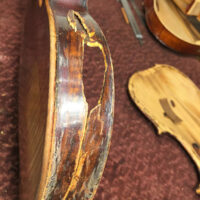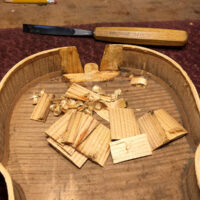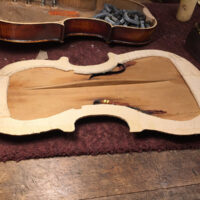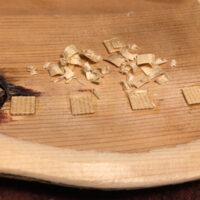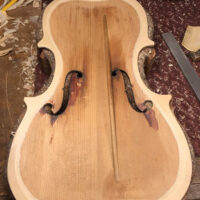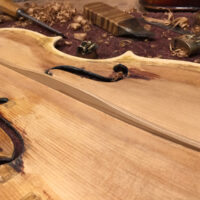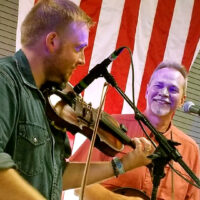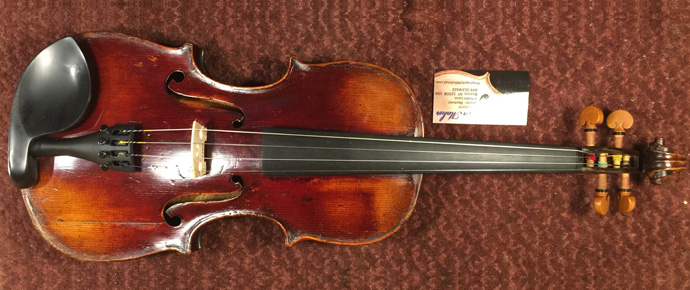
Adam Haynes’ Scotty Stoneman fiddle, after restoration was completed – photo by RJ Storm
Some of the most popular articles we have published in recent years have been about older instruments and the bluegrass artists who have owned them. With a life cycle of several hundred years for fiddles, and many guitars, mandolins, and banjos approaching the 100 year mark, it’s not uncommon for notable instruments to be owned by more than one prominent picker over the course of its existence. When the artists involved are legendary in their own right, it just adds more interest to the tale.
Such is the story we have today, about an effort this summer to restore an ancient fiddle that once belonged to Scotty Stoneman. Owing both to his fiery onstage personality and his early passing – only 42 years old when he died in 1973 – Scotty’s name evokes a sense of awe among current fiddlers when they discuss his music. A bluegrass fiddler of the first order, he was also a natural showman who wowed audiences with pure musicianship as well as trick fiddling.
Here’s an example from the early ’70s when he appeared on Del Reeves’ Country Carnival.
Like Carter Stanley before him, Scotty engaged in a life long battle with drinking, one he eventually lost due to alcohol poisoning. Before it took his life, many people remembered Stoneman as a gregarious drunk – what we might call a party animal today – but his hard life, and hard playing, took a toll on his instruments.
Adam Haynes, fiddler with The Grascals, is a Stoneman fan, so he was delighted when he came across a fiddle in St Louis that carried a tag inside indicating that it had belonged to Scotty. When he picked it up, the instrument was playable, but just barely, and he contacted his friend RJ Storm, a violin builder and restorer in Beacon, NY, who had built Adam’s primary fiddle to see about having it reworked.
He picks up the story there…
“I’ve had it about three years – it was playable but needed a lot of work. I recorded with it on Kristin Scott Benson’s CD, so it could be played, but it was in rough shape. It couldn’t have kept going very long.
You couldn’t really call it a valuable fiddle – an old Hoff fiddle – but because it was Scotty’s, I had to have it. It just has that little something extra that most fiddles don’t have, and I wanted the integrity of it to be intact in any restoration.
When I saw it it had been in St Louis for a long time. This one had an old tag in it, and said inside that Scotty had owned it and played it. Songwriter Ken McDuffey had gotten it from Scotty in 1967. Once I got it I showed it to Roni Stoneman, and she said that you could always tell one of Scotty’s fiddles, because he sweated so much when he played. She remembered having helped him repair it when he owned it.”
Haynes had met Storm several years ago at a festival in New York. The two became friends, leading to Storm building him an instrument.
When Adam reached out about restoring this one, RJ was in a quandary. And a bluegrass lover, he was a big Scotty Stoneman fan, but he knew that the sort of work required to put this one back in top shape would be extensive – and quite expensive.
“Jobs like this can cost as much as $20K, but I wanted to do Adam a favor and tackle it for a fee that was in the realm of a grasser’s budget.”
Once they agreed on a price, Adam sent the fiddle up to Storm’s shop and he started in on the process, which began with disassembly. This is a painstaking procedure, as the goal is to preserve all of the original wood in the instrument, especially where previous repairs have been done.
Storm shared some details on the fiddle, and what all he had to accomplish in the restoration.
“Part of the process after disassembly is to look carefully for notes, signatures, etc that would need to be preserved. We didn’t find anything.
The damage to this instrument was done cumulatively over time. The rib was crushed and re-glued, with large amounts of glue poorly applied.
Scotty played hard, and was a large man with huge fingers. The back of the neck near the body was so worn down that it could barely support the strings. They were right at the edge of the fingerboard, and the neck angle was too low so it had lost volume and tone. So we did a neck graft, keeping the original scroll and pegbox, to get the dimensions as they should be.
The top had been removed and replaced several times, maybe even before Scotty got it. A good repair would involve saving and replacing any little slivers of wood that might separate when removing the top, because if you don’t the edges of the top can get too thin over time. Many repairmen will just plane it down to smooth and put it back on.
This one was too thin, so the top had to be doubled as a result, adding wood and then replaning it to size. Some of the edges had to be replaced as well.
The bass bar wasn’t properly glued in, and wasn’t shaped right. So I built a new one from good new spruce. I fixed a lot of cracks as well, and had to unglue them as most had also been poorly repaired. Then we cleated the cracks and glued them back properly. Afterwards we matched the finish as best we could in touch ups. I had to replace the end block and the neck block since they were split too, which probably led to the split in the top.
The fingerboard had been planed down so many times that it was unusable. It was about as thick as a few sheets of notebook paper. But I was able to reuse that wood to make the heel button.
It’s finished now and Adam is playing it. It was a fun project, and an honorable thing to bring this fiddle back to life. It’s a part of history.”
And Haynes is delighted with the result.
“This was one of many fiddles that Scotty owned and played. It’s in top shape now for the next 200 years. I was worried it wouldn’t sound as good after restoration, with new wood and all that. But now it looks great, and it sounds so good.
My main fiddle is one Storm made, and now I can carry Scotty’s fiddle with it in a double case.”
Both Adam and RJ shared some photos of the fiddle, before and after.
Looks like a job well done!

